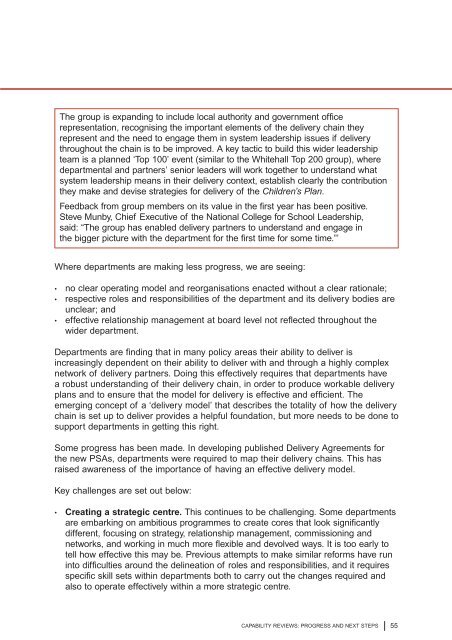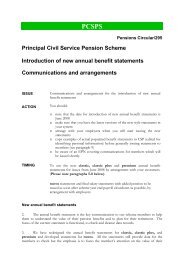Capability Reviews: Progress and Next Steps - The Civil Service
Capability Reviews: Progress and Next Steps - The Civil Service
Capability Reviews: Progress and Next Steps - The Civil Service
- No tags were found...
You also want an ePaper? Increase the reach of your titles
YUMPU automatically turns print PDFs into web optimized ePapers that Google loves.
<strong>The</strong> group is exp<strong>and</strong>ing to include local authority <strong>and</strong> government officerepresentation, recognising the important elements of the delivery chain theyrepresent <strong>and</strong> the need to engage them in system leadership issues if deliverythroughout the chain is to be improved. A key tactic to build this wider leadershipteam is a planned ‘Top 100’ event (similar to the Whitehall Top 200 group), wheredepartmental <strong>and</strong> partners’ senior leaders will work together to underst<strong>and</strong> whatsystem leadership means in their delivery context, establish clearly the contributionthey make <strong>and</strong> devise strategies for delivery of the Children’s Plan.Feedback from group members on its value in the first year has been positive.Steve Munby, Chief Executive of the National College for School Leadership,said: “<strong>The</strong> group has enabled delivery partners to underst<strong>and</strong> <strong>and</strong> engage inthe bigger picture with the department for the first time for some time.”’Where departments are making less progress, we are seeing:• no clear operating model <strong>and</strong> reorganisations enacted without a clear rationale;• respective roles <strong>and</strong> responsibilities of the department <strong>and</strong> its delivery bodies areunclear; <strong>and</strong>• effective relationship management at board level not reflected throughout thewider department.Departments are finding that in many policy areas their ability to deliver isincreasingly dependent on their ability to deliver with <strong>and</strong> through a highly complexnetwork of delivery partners. Doing this effectively requires that departments havea robust underst<strong>and</strong>ing of their delivery chain, in order to produce workable deliveryplans <strong>and</strong> to ensure that the model for delivery is effective <strong>and</strong> efficient. <strong>The</strong>emerging concept of a ‘delivery model’ that describes the totality of how the deliverychain is set up to deliver provides a helpful foundation, but more needs to be done tosupport departments in getting this right.Some progress has been made. In developing published Delivery Agreements forthe new PSAs, departments were required to map their delivery chains. This hasraised awareness of the importance of having an effective delivery model.Key challenges are set out below:• Creating a strategic centre. This continues to be challenging. Some departmentsare embarking on ambitious programmes to create cores that look significantlydifferent, focusing on strategy, relationship management, commissioning <strong>and</strong>networks, <strong>and</strong> working in much more flexible <strong>and</strong> devolved ways. It is too early totell how effective this may be. Previous attempts to make similar reforms have runinto difficulties around the delineation of roles <strong>and</strong> responsibilities, <strong>and</strong> it requiresspecific skill sets within departments both to carry out the changes required <strong>and</strong>also to operate effectively within a more strategic centre.CAPABILITY REVIEWS: PROGRESS AND NEXT STEPS55
















